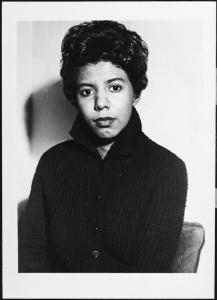 Lorraine Hansberry: 1930-1965
Lorraine Hansberry: 1930-1965
What happens to a dream deferred?
Does it dry up
Like a raisin in the sun?
Or fester like a sore–
And then run?
Does it stink like rotten meat?
Or crust and sugar over–
like a syrupy sweet?
Maybe it just sags
like a heavy load.
Or does it explode?
Hope deferred makes the heart sick,
but a dream fulfilled is a tree of life.
For those who have not read the play, there are spoilers.
Author, Lorraine Hansberry
There is more than one way of teaching people about people. One of the great playwrights of our time, Lorraine Hansberry gave the world what she knew–her passion, her experience, her creativity, and her genius. Emma Z. Rothberg, Ph.D. wrote her biography for the National Women’s History Museum:
“Lorraine Hansberry was born on May 19, 1930 at Provident Hospital on the South Side of Chicago. She was raised in a strong family, the youngest of three children born to Nannie Perry Hansberry and Carl Augustus Hansberry. Her father, Carl, founded Lake Street Bank, one of the first banks for African Americans in Chicago and also ran a successful real estate business. Her mother, Nannie, was a school teacher. Hansberry had other African American leaders in her family: her uncle William Leo Hansberry was a Professor of History at Howard University; her cousin, Shauneille Perry, was one of the first African American women to direct off-Broadway.
“Growing up on the South Side of Chicago, Hansberry and her family were involved in the racial justice movements of the era. Her parents were prominent members of the African American community and her father worked for the NAACP. When prominent African American community members and leaders came through Chicago, they went to the Hansberry’s home. The family hosted W.E.B. DuBois, Paul Robeson, Langston Hughes, Duke Ellington, and Jesse Owens.
“In 1937, Hansberry’s parents challenged Chicago’s restrictive housing covenants by moving into an all-white neighborhood. Their new white neighbors did not welcome the move and a mob gathered around the house. Someone threw a brick through the window, barely missing eight-year-old Hansberry’s head. Years later, Hansberry recalled her mother “patrolling the house all night with a loaded German luger.” When the Supreme Court of Illinois upheld the legality of the neighborhood’s restrictive covenant and forced the Hansberrys to leave the house, her parents sued. They took their case all the way to the Supreme Court. They won. Hansberry v. Lee (1940) helped outlaw legal housing discrimination across the United States.
“Hansberry graduated from Englewood High School in 1948 and enrolled at the University of Wisconsin-Madison. While studying, Hansberry became interested in theater, politics, and the global anti-colonial movement. She worked on the 1948 presidential campaign for the Progressive Party, wrote in support of the Mau Mau uprising in Kenya, and covered the case of an African American man executed after an all-white jury deliberated his case for three minutes. Hansberry left university before completing her degree. She studied painting in Chicago and Mexico before moving to New York in 1950 to take courses at the New School. By 1951, she was writing for Paul Robeson’s Freedom, a progressive publication that put her in touch with other literary and political mentors. She also studied with W.E.B. DuBois.”
On March 11, 1959, the original Broadway production of Lorraine Hansberry’s A Raisin in the Sun opened at the historic Ethel Barrymore Theatre in New York City. The play tells the story of a Black, working-class family living on the Southside of Chicago. It was the first play on Broadway to be written and produced by an African American woman. It won the New York Drama Critics’ award for best play. Hansberry was 29 when she became not only the first black recipient, but the youngest American to receive the award.
Hansberry’s friend James Baldwin wrote, “Never before, in the entire history of the American theater, had so much of the truth of Black people’s lives been seen on the stage.”
A Raisin in the Sun, Review
In a September 21, 2019 blog from Introvert Interrupted, the following commentary appeared:
“Everything in Hansberry’s play felt extremely relevant and real to me, from the characters who were trying to figure out how to spend their new found fortune to the themes that Hansberry brought up about African-American’s place in American society. Even on paper, the characters’ emotions and actions are mapped out and shown so well that watching a film or live performance for Hansberry’s work was actually unnecessary. I personally enjoyed each aspect of the play and could see how certain issues such as, the idea of the black man’s ambitions being unrecognized or the questioning of whether blacks are better off assimilating into the American culture vs. African culture are still relevant.
“Each person in the family has big dreams of what they want to do with the money when they get it, however, Walter is the most vocal about his plans. When the check finally comes, Mama takes the money and buys a house in an all-white neighborhood with half of it and gives the rest to Walter with strict instructions to put half in the bank for Beneatha’s medical education and use the other half for whatever he sees fit. Unfortunately, Walter does the opposite and things start to unravel.”
The Lessons of A Raisin in the Sun
There are so many timely, relevant lessons that can be learned from A Raisin in the Sun, regardless of one’s ethnic background. Family relationships and dynamics are at the front. Love, independence, dreams, individuality, maturity, and seeking the American dream, fill its pages and resonate with everyone in this country in all periods of our history. From the moment I first picked up the manuscript, I was enchanted. Hansberry offered the world such a keen revelation! A Raisin in the Sun is raw truth, a truth that not everyone considers or confronts, but should.
Hansberry wrote one more play. The Sign in Sidney Brunstein’s Window was inspired by her marriage. The play ran for 101 performances and dealt with themes of race, gender, and sexuality. The Sign would be the final Hansberry play produced.
Tragically, on January 12, 1965, Hansberry died of pancreatic cancer. She was 34 years old. The Sign closed the same day.
My Favorite Moment in A Raisin in the Sun
In closing, I would like to quote my favorite moment from A Raisin in the Sun. Walter Lee has just lost the family’s money, and his sister Beneatha reacts in hurt and anger. Mama’s (Lena’s) reply is timeless and wise, a stellar example of grace:
“Beneatha: Love him? There is nothing left to love.
Mama: There is always something left to love. And if you ain’t learned that, you ain’t learned nothing. (Looking at her) Have you cried for that boy today? I don’t mean for yourself and for the family ’cause we lost the money. I mean for him: what he been through and what it done to him. Child, when do you think is the time to love somebody the most? When they done good and made things easy for everybody? Well then, you ain’t through learning – because that ain’t the time at all. It’s when he’s at his lowest and can’t believe in hisself ’cause the world done whipped him so! when you starts measuring somebody, measure him right, child, measure him right. Make sure you done taken into account what hills and valleys he come through before he got to wherever he is.”
A Raisin in the Sun is a classic to be celebrated on stage and in the classroom. It is one of my very favorites. Movie versions are available, but short of a stage production, the text “can’t be beat.” To paraphrase Dr. Martin Luther King, Jr., it’s not just Black history, or Women’s history, it’s American history.
God bless you as you learn to love and to find your strength as did the characters in the play.













